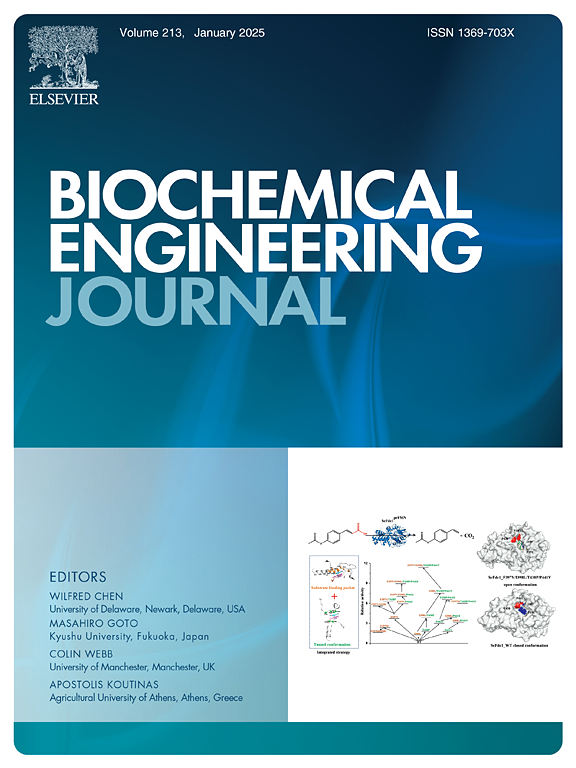Identifying fibril formation on interdigitated parallel microelectrodes for diagnosing Parkinson's disease
IF 3.7
3区 生物学
Q2 BIOTECHNOLOGY & APPLIED MICROBIOLOGY
引用次数: 0
Abstract
Parkinson’s Disease (PD), commonly seen in adults over the age of 65, is the second most common neurodegenerative disorder. Researchers are working towards developing a highly sensitive biosensor for diagnosing PD. Diamond-gold nanomaterials hybrid on interdigitated parallel microelectrode (IDME) biosensor is introduced for diagnosing PD. Alpha-synuclein contributes to the progression of PD, it was used as a target to diagnose PD, and aptamer was immobilized as a capture molecule. For higher aptamer immobilization, IDME was modified by diamond nanomaterial through 1,1′-Carbonyldiimidazole linker and then aptamer (with or without gold nanoparticle conjugated) was attached on the diamond by using an amine-linker. This aptamer immobilized surfaces detect the alpha-synuclein by aptamer-antibody sandwich and lowers the detection limit to 1 aM [y = 1.5679x − 1.7834; R² = 0.9904] in the buffer sample and 10 aM in an artificial cerebrospinal fluid on a linear regression from 1 aM until 1 nM. In addition, control performances with DJ-1, PARK-1, and complementary anti-alpha-synuclein aptamer failed to increase the current responses confirm the specific detection of alpha-synuclein. This diamond modified IDME quantifies the alpha-synuclein at its lower level and helps to diagnose PD.
鉴定互指平行微电极上的纤维形成用于诊断帕金森病
帕金森病(PD)常见于65岁以上的成年人,是第二常见的神经退行性疾病。研究人员正致力于开发一种诊断帕金森病的高灵敏度生物传感器。介绍了一种用于PD诊断的金刚石-金纳米材料杂化交叉指状平行微电极生物传感器。α -突触核蛋白参与PD的进展,被用作诊断PD的靶标,适配体被固定化作为捕获分子。为了提高适配体的固定化程度,采用金刚石纳米材料通过1,1′-羰基二咪唑连接剂对IDME进行修饰,然后通过胺类连接剂将适配体(带或不带金纳米颗粒共轭)附着在金刚石上。该适配体固定化表面通过适配体-抗体夹心检测α -突触核蛋白,检测限降至1 aM [y = 1.5679x−1.7834;R²= 0.9904]在缓冲液样品和人工脑脊液中10 aM的线性回归从1 aM到1 nM。此外,DJ-1、PARK-1和互补的抗α -synuclein适配体的对照性能未能提高当前的反应,证实了α -synuclein的特异性检测。这种金刚石修饰的IDME在较低水平上定量α -突触核蛋白,有助于PD的诊断。
本文章由计算机程序翻译,如有差异,请以英文原文为准。
求助全文
约1分钟内获得全文
求助全文
来源期刊

Biochemical Engineering Journal
工程技术-工程:化工
CiteScore
7.10
自引率
5.10%
发文量
380
审稿时长
34 days
期刊介绍:
The Biochemical Engineering Journal aims to promote progress in the crucial chemical engineering aspects of the development of biological processes associated with everything from raw materials preparation to product recovery relevant to industries as diverse as medical/healthcare, industrial biotechnology, and environmental biotechnology.
The Journal welcomes full length original research papers, short communications, and review papers* in the following research fields:
Biocatalysis (enzyme or microbial) and biotransformations, including immobilized biocatalyst preparation and kinetics
Biosensors and Biodevices including biofabrication and novel fuel cell development
Bioseparations including scale-up and protein refolding/renaturation
Environmental Bioengineering including bioconversion, bioremediation, and microbial fuel cells
Bioreactor Systems including characterization, optimization and scale-up
Bioresources and Biorefinery Engineering including biomass conversion, biofuels, bioenergy, and optimization
Industrial Biotechnology including specialty chemicals, platform chemicals and neutraceuticals
Biomaterials and Tissue Engineering including bioartificial organs, cell encapsulation, and controlled release
Cell Culture Engineering (plant, animal or insect cells) including viral vectors, monoclonal antibodies, recombinant proteins, vaccines, and secondary metabolites
Cell Therapies and Stem Cells including pluripotent, mesenchymal and hematopoietic stem cells; immunotherapies; tissue-specific differentiation; and cryopreservation
Metabolic Engineering, Systems and Synthetic Biology including OMICS, bioinformatics, in silico biology, and metabolic flux analysis
Protein Engineering including enzyme engineering and directed evolution.
 求助内容:
求助内容: 应助结果提醒方式:
应助结果提醒方式:


